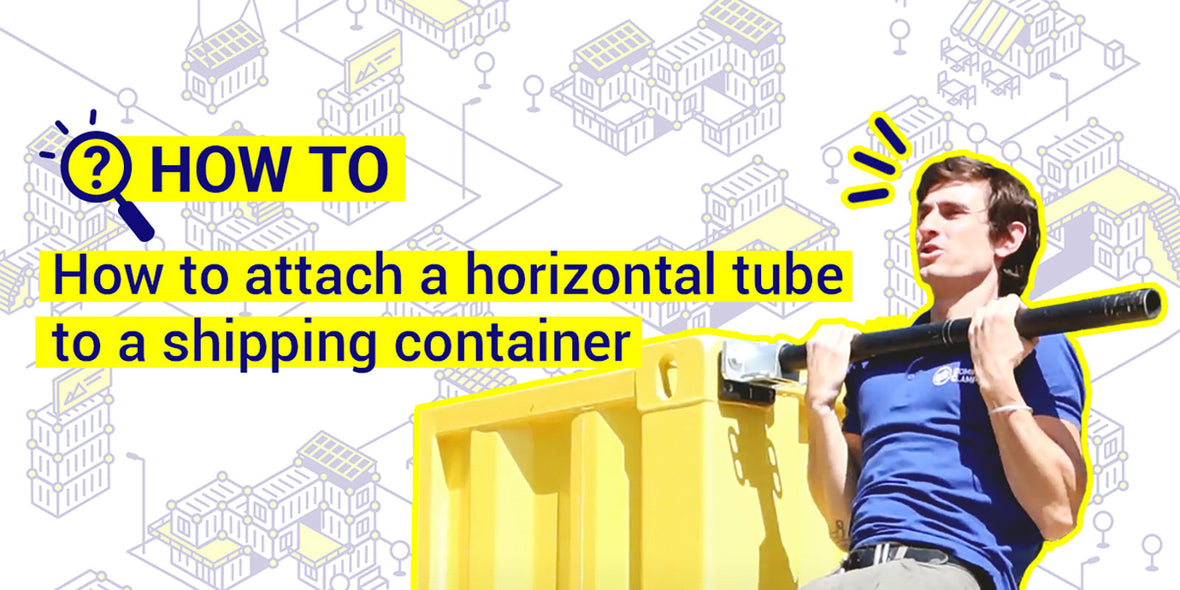
How to attach a horizontal tube to a shipping container
In a previous blog we showed you various ways to attach a vertical tube to a shipping container using Domino Clamps and vertical tube clamps (also known as palm railing style tube clamps). This time around we’ll look at how to attach one horizontally out of the side of the corner casting so that it comes out at a 90 degree angle from the vertical one.
How does a horizontal bar on my shipping container help me?
This will be useful when needing to hang things at about the same height as the top of your container. Hanging things from a horizontal bar is obviously a lot easier than securing them against a vertical one, but as we’ll show you, there are some considerations to bear in mind.
One of the big benefits of this method is that it offers a way of attaching something to the side of a shipping container, as opposed to the top. This means that if you had containers stacked on top of one another, you could still attach a bracket to the side, whereas usually the first port of call would be to attach something to the upper side of the shipping container, where you could use the leverage of something gripped into the top hole of the corner casting to help support the weight of what you're attaching. But with Domino's high strength and unique attachment method, being able to bolt a horizontal steel hanging bracket directly to the side of the casting is now possible.

This is where Interclamp’s tube clamps really come into their own, as they have two attachments in their range which are designed for attaching a vertical railing to a flat horizontal plane. Using them carefully outside of their intended design, we can bolt them to a vertical plane; ie onto one of our Domino Clamps, and now the tube exits the clamp horizontally. Both these fixtures feature that crucial 100mm spacing between the bolt hold so that they can be bolted directly to the Domino, and in turn then to a shipping container.
We offer a horizontal (perpendicular) tube clamp with or without a kickplate for 48mm tube. Both castings have approximately 100mm bolt spacing, so will bolt directly to our Domino clamps using 35mm M12 screws.

Doing the job safely
It should be clear here that we’re using this clamp outside of its intended function. Inserting the tube into the clamp horizontally raises a couple of issues to be aware of. The first is that the grub screws now have the opportunity to point down, meaning that they could come loose over time or with exposure to excessive vibration. Point them up to avoid this, or add some threadlock.
Using the horizontal (perpendicular) tube clamp in this way is probably best for relatively light use, since adding excessive downward force to a beam coming horizontally off a container will significantly lower the Domino Clamp’s NWL. However, used carefully and with these things in mind, attaching a bar or horizontal support to a container is a really handy extra option. 
Method
Much like their range of vertical tube clamp (also known as palm railing tube clamps) fixings, Interclamp's horizontal (perpendicular) tube clamps have a bolt spacing of 102mm. because the holes are much larger than needed for the M12 bolts, this allows enough room to bolt them directly to out Domino Clamps.
- Make sure that your shipping container's corner casting is clean and free of internal debris, and fix the Domino Clamp to it following our detailed instructions.
- Now, using a horizontal (perpendicular) tube clamp, and the two 35mm M12 screws provided, fix the tube clamp onto the Domino on the side of your shipping container.
- Next, put the appropriate sized steel or aluminium tube into the tube clamps and tighten up the grub screws on the base flange clamp using an 8mm hex key.
Now you can hang what you need from this horizontal hanging point on your shipping container, paying special attention to the load limits laid out in our technical sheet.
For more ingenious container solutions, useful information and offers delivered direct to your inbox, sign up to our information email 📨 or subscribe to our YouTube channel 📺





